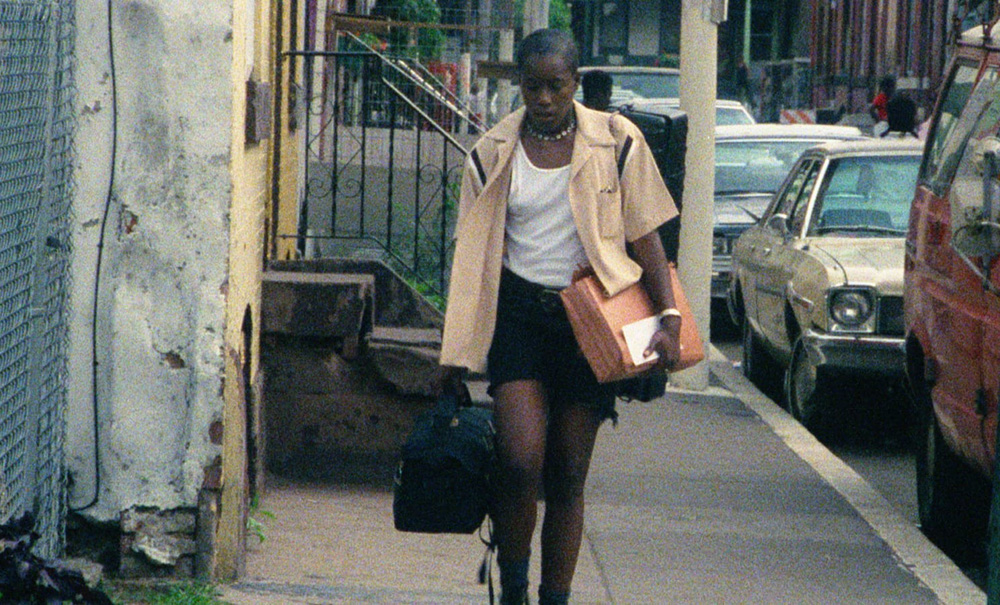If she hadn’t seen so many others written out of history, Cheryl Dunye never would’ve had to make “The Watermelon Woman” in the first place, but still it had to be crushing to experience it happen in real time when as any independent filmmaker could tell you only after making their first feature, there will never be any greater custodian for it. Even in the best case scenario where it is picked up by a distributor, a film could easily get lost amidst regime changes and years gone by after its initial release and in spite of having seen this movie play out before, after building “The Watermelon Woman” around a filmmaker looking to restore the legacy of a Black silent film star named Fae Richards, who would fall through the cracks in Hollywood lore due to more nefarious neglect over the generations that followed, rewriting the ending off screen was going to be more difficult than what she was able to do on it.
“Academics love this [film] – it’s a huge hit in the academic [world] and that kept me alive,” said Dunye, who specifically noted an essay by Thelma Foote that kept it in the cultural conversation. “Then it was adjunct teaching and doing academic work, so I had my foot in there and the celebration was more on that side. By 20, I realized nobody was going to celebrate it but me, so I kicked out a big celebration of it and toured with it and had a little exhibit. I think my caring about myself again allowed for it to have a little rebirth at that point. Artists should care about their work — living artists in particular — and I think the care of me wanting to make sure that the project gets to the world [led to getting it] to Criterion.”
This week’s release of “The Watermelon Woman” as part of the Criterion Collection is the culmination of Dunye pushing a boulder up a hill for the better part of 30 years with a frisky comedy that has lost none of its edge since it premiered at the Berlin Film Festival in 1996. In an era of American indie cinema that introduced a number of new voices, Dunye was, and rather unfortunately, remains unique and whether the director wanted to be a pioneer, she took on the role with great aplomb, casting herself in “The Watermelon Woman” as someone resembling so many other filmmakers, biding her time as a wedding videographer on her days away from working at a local video store in Philadelphia with her friend Tamara (Valarie Walker), only for a true auteur to be revealed in the full realization of a character loosely based on herself that she honed in a series of shorts she’d come to call “Dunyementaries,” following her adventures navigating both the art world and the dating scene as a Black queer woman.
With a savvy mix of video diaries charting her personal life and a meticulously constructed backstory for the fictional Richards, based on the careers of contemporaries such as Hattie McDaniel and Josephine Baker, Dunye inserts herself into a narrative in ways that cannot be denied, with the rough edges of a limited budget that the director had to scrape together well after production on the film started now appearing as righteous disruptions of tales repeated for too long without question. The director has actively taken her own words from “The Watermelon Woman” to heart that “sometimes you have to create your own history” and while refusing to let the film disappear, she’s continued to make vital work, whether it’s directing episodes of “Queen Sugar” and “Lovecraft Country” or moving forward with a planned adaptation of Audre Lorde’s “Zami: A New Spelling of My Name.” With her debut now ripe for rediscovery, along with her early shorts, on a beautiful new Blu-ray edition where a restoration has made the images as fresh as the film’s ideas, Dunye spoke about the less-discussed aspects of being a filmmaker and the need to preserve their own work, bringing the underground so vibrantly into the foreground and the importance of not waiting around to practice your calling.
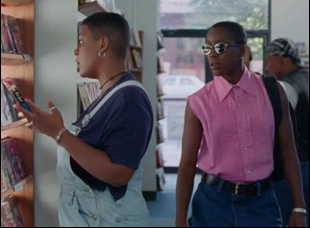
Yes, for a chunk of time there, we could not find any prints and our former distributor, wherever they were storing stuff in New York, they were not that great. When you are a queer or color filmmaker in the ‘90s, you go with any distributor, [because] you’re just so happy that you get anything, and they’re a great distributor for some, but not for me because they lost our negatives. Luckily out of the blue, we are shifting to Criterion right now and in grabbing everything back, a print was found somewhere, so that’s what we’re sending around and we feel so blessed by that.
I’m really happy to have this revival come to the world. We didn’t have the eyes of the Hollywood or whatever it was called then – and there was no Indywood really at that point, [just] the beginnings of it – looking my way, so it feels great to be re-embraced and reinvigorated by this process and invigorating people to do whatever they want with it, in the sense of thinking about their past, present, and futures. I know what it’s doing for me in the sense of, people are like, “Well, who owns the film? I go, “I do, of course.” They’re like, “Well, why didn’t you make ‘Watermelon Woman 2’” And I’m like, “Oh my God, you guys. I did this back in the ’90s. I tried to ask for a second one and everybody shot me down, so now you want one?” It could be an interesting story, so it’s really generative on so many levels.
Something that may have been practical at the time but now seems really distinctive is the use of mixed media and the way the film moves between film and video involves these fades that actually sharpen some of the humor or allow for rumination. Was that something that just felt right at the time when there was no real template for this?
No, there was no template and I come from the art world. I was a video artist, so I was shooting on Super 8 for film and transferring it to VHS and I primarily shot on VHS or whatever came after that, or mini DV, but I thought because VHS was so cheap, we were watching videos, we could shoot on them, so to save the budget, what if Cheryl [the character] makes a film with film and we shoot all [the video diaries] on video and that cut the price of what our film would need and then we merge all two together in the end. Now, everybody’s like, “That’s great. Brilliant!” So we do it, but we realized there was no digital technology to do that merge – we were using analog to do that digital [version], so it turned into big shenanigans in that sense. And it was very difficult to get it back onto 16 and do all the editing that we needed to do and make all the cuts with the timing and the speeds of film versus that type of media and using an early version of the AVID. It was just crazy.
We were lucky to have an editing company in Philadelphia come on board to help us do that and eventually other turned into executive producers of the film because we were taking up in their space for so much time and because they ended up loving the project. The technology made the film in the sense that we were very limited in the way that we could do the effects we did and the fades, especially trying to keep the budget down on the video side and making it look like video, then on the film side, having that film. So that was crazy, but that just tells you who I am and how I love living in the world of making art, putting it all out there and taking chances. And I’m pleased that I took that chance and sorted out my life to pull that together.
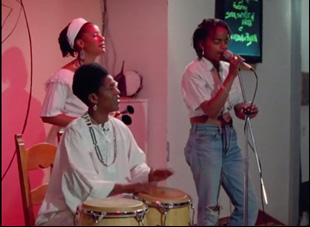
Yes, it was very important for me to use my own community of people that inspired me. People that I looked up to, to collaborators, my cultural producers in my queer, lesbian world of Black people and people who are writing books. Camille Paglia was that – she was controversial and sexual. Her novel was out, and everyone was going crazy about it. She happened to be dating one of my friend’s friends, so I was able to walk up to her and twist her a pitch to be in it because she didn’t know it was going to go like that. [laughs] I knew Toshi [Reagon, who appears as a street musician], I knew Sara [Vogt, who plays a silent film star]. My shorts had shown in the New York Lesbian and Gay Film Festival, and Sara was involved in that. So I was like, Brian Freeman of the Pomo Afro Homos [should be in the film]. I wanted to document our culture, and nobody was. So why not? That’s my Hollywood, and that’s what became so interesting.
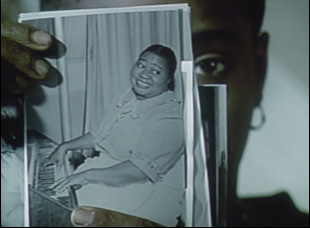
Right. Well, my mom was that person, and that was actually my house that I grew up in. That’s the living room. Those were the things that were on the table, and she told me these stories. Of course, when I was researching, I had to like jiggle her mind a little bit to get a little bit more out of her about it, but who else could play your mom other than your mom, right? So she put on the mom performance and she was a much more vibrant person [in real life] than that. She did a great job, toning it down and having how many people in her house [to shoot the film], and we actually used the little dining room off the side of the kitchen to shoot the footage of Ira Jeffries, the woman who who had the photos [that inspired Faye Richards]. When I went to research at the Lesbian Herstory Archives in New York, I found a collection of Black lesbian photos from a woman who had donated them — Ira Jeffries — and I found out that she was alive, so I put her in the film [playing Shirley Hamilton]. Because you can’t not do that, you know? If anybody else in the film that I historically found on the way — Stepin Fetchit, Butterfly McQueen — any of those people I was able to meet them on that journey to tell that story, I would have because it’s so important to see that. Again, it was below the surface at that time, so I had a lot more flexibility with creating whatever I wanted.
There’s one scene early on in the movie that I think anyone in a creative field can relate to – and I may be reading too much into this, but it’s where Cheryl is describing herself as a filmmaker and goes back to correct herself by saying “someone that shoots videos” since it doesn’t feel professional yet. Was there actually a moment along the way where you first remember saying confidently, “I am a filmmaker”?
I am. I mean, one thing — you have to. I say to young filmmakers, “you’re probably asking me [something] I was saying to myself then” and doing it now is one or two different things because the world is different. But you’ve got to show up and label yourself what you want to be. If you’re a journalist, you got to start writing. If you’re a filmmaker, you got to start showing up. You’ve got to do the things that you want to be to become that, whatever that may be, and practice. And practicing is, of course, doing wedding videos, which I did, and I had to document those experiences [in “Watermelon Woman”] because they were crazy. Practices were recording somebody’s dance troupe at a community center, so it was great to put that in there. It was fun that I allowed Valarie Walker, who played Tamara, [and myself] to just riff on that [as video store employees], because we all have those stories about working for the peeps and how they’re crazy and [saying] “No girl, give me my money.” And I love that it started to form this dynamic and banter between the two of us [like] Tom and Jerry, or Thing #1 and Thing #2, [the most] dynamic duo that there could ever be, so that really felt great to me.
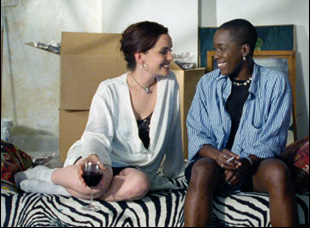
Well, the personal stuff is never out of the way. [laughs] It just gets bigger and different. I have kids now and they have their own worlds and dramas, so it just gets bigger and shifts into more groovy things. I’ve been in relationships and marriages and have a wonderful relationship now, so there’s so many stories to tell from this body and this person who decided to take this journey. It’s never over. As we were talking about at the beginning of this conversation, the “Watermelon Woman 2” idea is on fire in my mind right now, so [the next project] might look a lot like the magic that I started before, and it’s like what Kevin Smith did with “Clerks,” they came back again and again, and maybe there’s a moment for this to happen again. I didn’t know that [“Watermelon Woman” itself] was going to go this long, right? You never know. Of course, you want your work to live forever, but I didn’t know the discovery was going to happen again and again. I knew that I was breaking ground because there was nothing there before me, and when you realize there’s nothing to lose, go for it. That’s really what it is.
“The Watermelon Woman” is out now on Blu-ray from Criterion.




